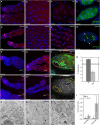Autophagy in Drosophila ovaries is induced by starvation and is required for oogenesis
- PMID: 21151027
- PMCID: PMC3131947
- DOI: 10.1038/cdd.2010.157
Autophagy in Drosophila ovaries is induced by starvation and is required for oogenesis
Abstract
Autophagy, an evolutionarily conserved lysosome-mediated degradation, promotes cell survival under starvation and is controlled by insulin/target of rapamycin (TOR) signaling. In Drosophila, nutrient depletion induces autophagy in the fat body. Interestingly, nutrient availability and insulin/TOR signaling also influence the size and structure of Drosophila ovaries, however, the role of nutrient signaling and autophagy during this process remains to be elucidated. Here, we show that starvation induces autophagy in germline cells (GCs) and in follicle cells (FCs) in Drosophila ovaries. This process is mediated by the ATG machinery and involves the upregulation of Atg genes. We further demonstrate that insulin/TOR signaling controls autophagy in FCs and GCs. The analysis of chimeric females reveals that autophagy in FCs, but not in GCs, is required for egg development. Strikingly, when animals lack Atg gene function in both cell types, ovaries develop normally, suggesting that the incompatibility between autophagy-competent GCs and autophagy-deficient FCs leads to defective egg development. As egg morphogenesis depends on a tightly linked signaling between FCs and GCs, we propose a model in which autophagy is required for the communication between these two cell types. Our data establish an important function for autophagy during oogenesis and contributes to the understanding of the role of autophagy in animal development.
Figures




References
-
- Rusten TE, Lindmo K, Juhasz G, Sass M, Seglen PO, Brech A, et al. Programmed autophagy in the Drosophila fat body is induced by ecdysone through regulation of the PI3K pathway. Dev Cell. 2004;7:179–192. - PubMed
-
- Scott RC, Schuldiner O, Neufeld TP. Role and regulation of starvation-induced autophagy in the Drosophila fat body. Dev Cell. 2004;7:167–178. - PubMed
-
- Drummond-Barbosa D, Spradling AC. Stem cells and their progeny respond to nutritional changes during Drosophila oogenesis. Dev Biol. 2001;231:265–278. - PubMed
Publication types
MeSH terms
Substances
LinkOut - more resources
Full Text Sources
Molecular Biology Databases
Research Materials

